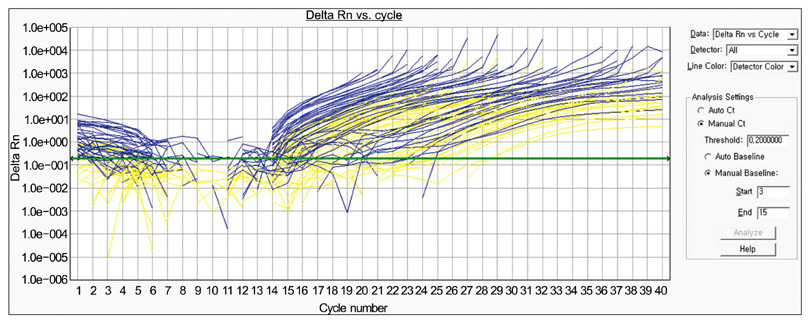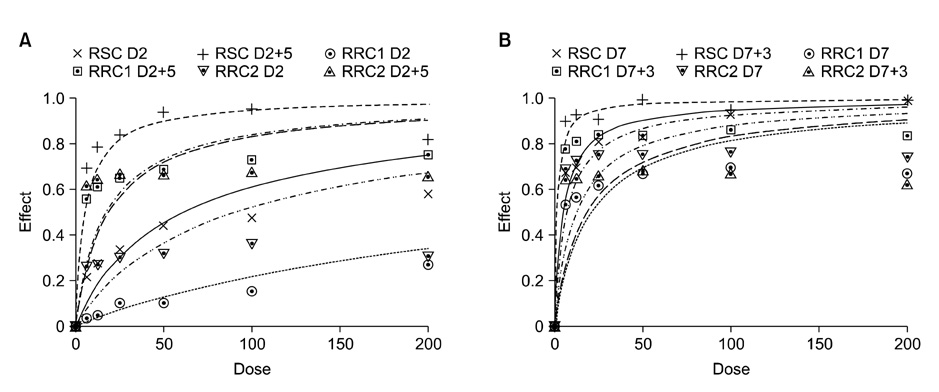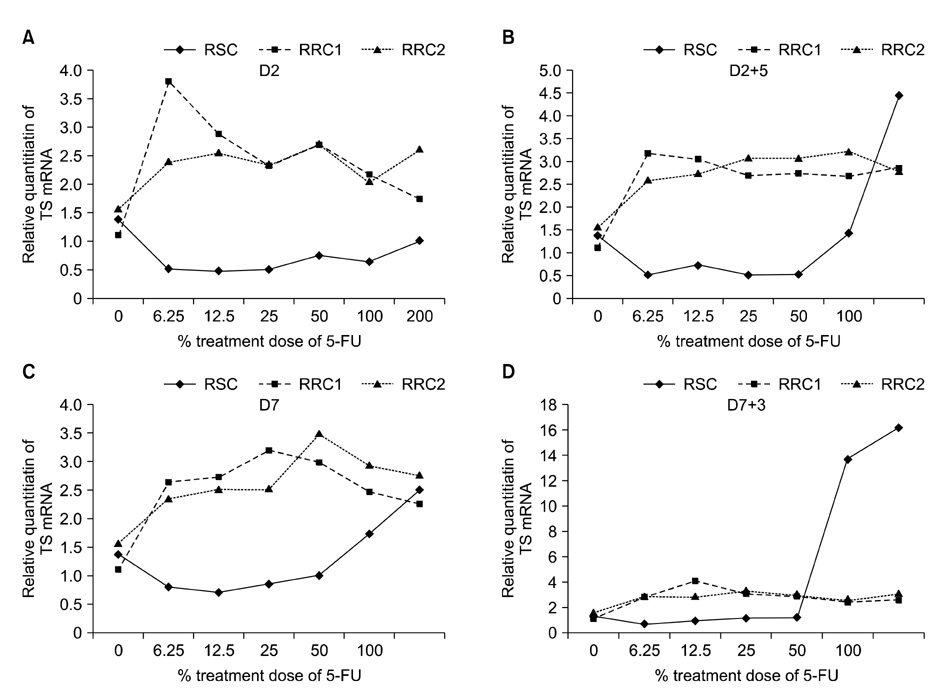J Korean Surg Soc.
2012 Jan;82(1):28-34. 10.4174/jkss.2012.82.1.28.
A practical approach for assessing chemosensitivity in colorectal cancer cell lines by comparative analysis of cell viability and thymidylate synthase mRNA expression
- Affiliations
-
- 1Department of Laboratory Medicine, Kosin University Gospel Hospital, Kosin University College of Medicine, Busan, Korea. terminom@hanmail.net
- KMID: 1437752
- DOI: http://doi.org/10.4174/jkss.2012.82.1.28
Abstract
- PURPOSE
The purpose of this study is to suggest a probable problem in chemosensitivity tests performed in practice and to speculate on practicable measures for more accurate chemosensitivity evaluation.
METHODS
Three colorectal cancer cells (RSC, RRC1, and RRC2) were treated with 5-fluorouracil (5-FU). Inhibition percentage (%inhibition) of cancer cells and relative quantitation of thymidylate synthase (TS) mRNA were measured on day 2, day 5 after replacement of 70% media on day 2, day 7, and day 3 after replacement of all media on day 7. Doses that produced 50% inhibition (Dm) were calculated to evaluate drug effect. Relative quantitation of TS mRNA and correlations between TS mRNA levels and 5-FU concentrations were analyzed.
RESULTS
RRC1 was more resistant than RRC2 on day 7, but Dm value of RRC2 increased three days after replacement of media from 12.3 to 18.1. Mean TS mRNA levels of RSC on D2 and D7 were significantly lower than those of RRC1 and RRC2, respectively (P = 0.004, P = 0.004 on D2; P = 0.010, P = 0.006 on D7). TS mRNA levels in RRC1 were significantly reversely correlated with 5-FU concentrations on day 2 (correlation coefficient = -0.867, P = 0.015). On the other hand, correlations were not significant in RRC2 (r = 0.067).
CONCLUSION
Evaluating %inhibition of cancer cells at one point in chemosensitivity tests seems to be inadequate in determining chemotherapeutic regimens. Multilateral approaches, such as trials evaluating cancer cell survival before and after media replacement and correlations between TS mRNA levels and 5-FU concentrations, needs to be implemented for the practical application of chemosensitivity tests.
Keyword
MeSH Terms
Figure
Reference
-
1. Rubinstein LV, Shoemaker RH, Paull KD, Simon RM, Tosini S, Skehan P, et al. Comparison of in vitro anticancer-drug-screening data generated with a tetrazolium assay versus a protein assay against a diverse panel of human tumor cell lines. J Natl Cancer Inst. 1990. 82:1113–1118.2. Sevin BU, Peng ZL, Perras JP, Ganjei P, Penalver M, Averette HE. Application of an ATP-bioluminescence assay in human tumor chemosensitivity testing. Gynecol Oncol. 1988. 31:191–204.3. Kinoshita M, Kodera Y, Hibi K, Nakayama G, Inoue T, Ohashi N, et al. Gene expression profile of 5-fluorouracil metabolic enzymes in primary colorectal cancer: potential as predictive parameters for response to fluorouracil-based chemotherapy. Anticancer Res. 2007. 27:851–856.4. Huh JW, Park YA, Lee KY, Sohn SK. Heterogeneity of adenosine triphosphate-based chemotherapy response assay in colorectal cancer--secondary publication. Yonsei Med J. 2009. 50:697–703.5. Furukawa T, Kubota T, Hoffman RM. Clinical applications of the histoculture drug response assay. Clin Cancer Res. 1995. 1:305–311.6. Blumenthal RD. In vitro assays. Chemosensitivity. 2005. Vol. 1. Totowa: Humana Press.7. Ishikawa Y, Kubota T, Otani Y, Watanabe M, Teramoto T, Kumai K, et al. Dihydropyrimidine dehydrogenase activity and messenger RNA level may be related to the antitumor effect of 5-fluorouracil on human tumor xenografts in nude mice. Clin Cancer Res. 1999. 5:883–889.8. Langenbach RJ, Danenberg PV, Heidelberger C. Thymidylate synthetase: mechanism of inhibition by 5-fluoro-2'-deoxyuridylate. Biochem Biophys Res Commun. 1972. 48:1565–1571.9. Jung H, Lee JI, Lee HH, Kim SH, Hur H, Jeon HM. Gastric cancer susceptibility according to methylenetetrahydrofolate reductase and thymidylate synthase gene polymorphism. J Korean Surg Soc. 2010. 79:27–34.10. Johnston PG, Drake JC, Trepel J, Allegra CJ. Immunological quantitation of thymidylate synthase using the monoclonal antibody TS 106 in 5-fluorouracil-sensitive and -resistant human cancer cell lines. Cancer Res. 1992. 52:4306–4312.11. Van Triest B, Peters GJ. Thymidylate synthase: a target for combination therapy and determinant of chemotherapeutic response in colorectal cancer. Oncology. 1999. 57:179–194.12. Grem JL, Danenberg KD, Behan K, Parr A, Young L, Danenberg PV, et al. Thymidine kinase, thymidylate synthase, and dihydropyrimidine dehydrogenase profiles of cell lines of the National Cancer Institute's Anticancer Drug Screen. Clin Cancer Res. 2001. 7:999–1009.13. Johnston PG, Lenz HJ, Leichman CG, Danenberg KD, Allegra CJ, Danenberg PV, et al. Thymidylate synthase gene and protein expression correlate and are associated with response to 5-fluorouracil in human colorectal and gastric tumors. Cancer Res. 1995. 55:1407–1412.14. Salonga D, Danenberg KD, Johnson M, Metzger R, Groshen S, Tsao-Wei DD, et al. Colorectal tumors responding to 5-fluorouracil have low gene expression levels of dihydropyrimidine dehydrogenase, thymidylate synthase, and thymidine phosphorylase. Clin Cancer Res. 2000. 6:1322–1327.15. Okumura K, Mekata E, Shiomi H, Naitoh H, Abe H, Endo Y, et al. Expression level of thymidylate synthase mRNA reflects 5-fluorouracil sensitivity with low dose and long duration in primary colorectal cancer. Cancer Chemother Pharmacol. 2008. 61:587–594.16. Peters GJ, Backus HH, Freemantle S, van Triest B, Codacci-Pisanelli G, van der Wilt CL, et al. Induction of thymidylate synthase as a 5-fluorouracil resistance mechanism. Biochim Biophys Acta. 2002. 1587:194–205.17. Mauritz R, van Groeningen CJ, Smid K, Jansen G, Pinedo HM, Peters GJ. Thymidylate synthase and dihydropyrimidine dehydrogenase mRNA expression after administration of 5-fluorouracil to patients with colorectal cancer. Int J Cancer. 2007. 120:2609–2612.18. Brennetot C, Buhard O, Jourdan F, Flejou JF, Duval A, Hamelin R. Mononucleotide repeats BAT-26 and BAT-25 accurately detect MSI-H tumors and predict tumor content: implications for population screening. Int J Cancer. 2005. 113:446–450.19. Elsaleh H, Joseph D, Grieu F, Zeps N, Spry N, Iacopetta B. Association of tumour site and sex with survival benefit from adjuvant chemotherapy in colorectal cancer. Lancet. 2000. 355:1745–1750.20. Ribic CM, Sargent DJ, Moore MJ, Thibodeau SN, French AJ, Goldberg RM, et al. Tumor microsatellite-instability status as a predictor of benefit from fluorouracil-based adjuvant chemotherapy for colon cancer. N Engl J Med. 2003. 349:247–257.21. Bocci G, Di Paolo A, Barbara C, Masi G, Fornaro L, Loupakis F, et al. Pharmacokinetics, a main actor in a many-sided approach to severe 5-FU toxicity prediction. Br J Clin Pharmacol. 2009. 67:132–134.22. Hitre E, Budai B, Adleff V, Czeglédi F, Horáth Z, Gyergyay F, et al. Influence of thymidylate synthase gene polymorphisms on the survival of colorectal cancer patients receiving adjuvant 5-fluorouracil. Pharmacogenet Genomics. 2005. 15:723–730.
- Full Text Links
- Actions
-
Cited
- CITED
-
- Close
- Share
- Similar articles
-
- Drug Resistance to 5 - Fluorouracil and Overexpression of Thymidylate Synthase mRNA in Human Gastrointestinal Malignancies
- Relationship between Expression of Thy- midylate Synthase mRNA and Resistance of Colon and Gastric Cancer Cells to 5-FU
- The Expression of Multidrug Resistance-Associated Protein (MRP) and the Chemosensitivity in Gastric Cancer Cell Lines
- The effect of Thymidylate Synthetase extression in stomach cancer tissues on the prognosis
- Relationship between the Expression of Apoptosis-Related Proteins and Chemosensitivity in Gastric Cancer Cell Lines




